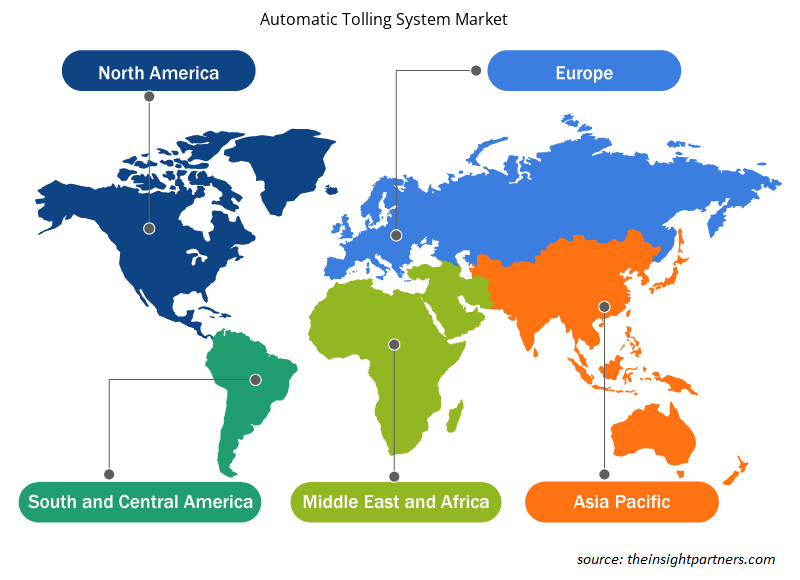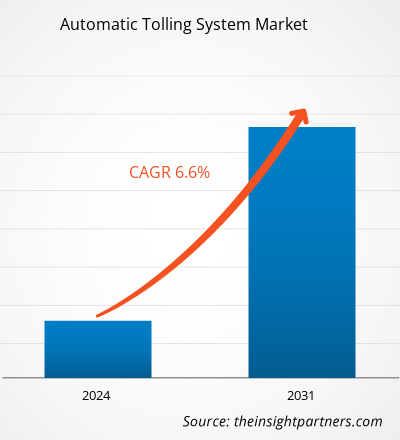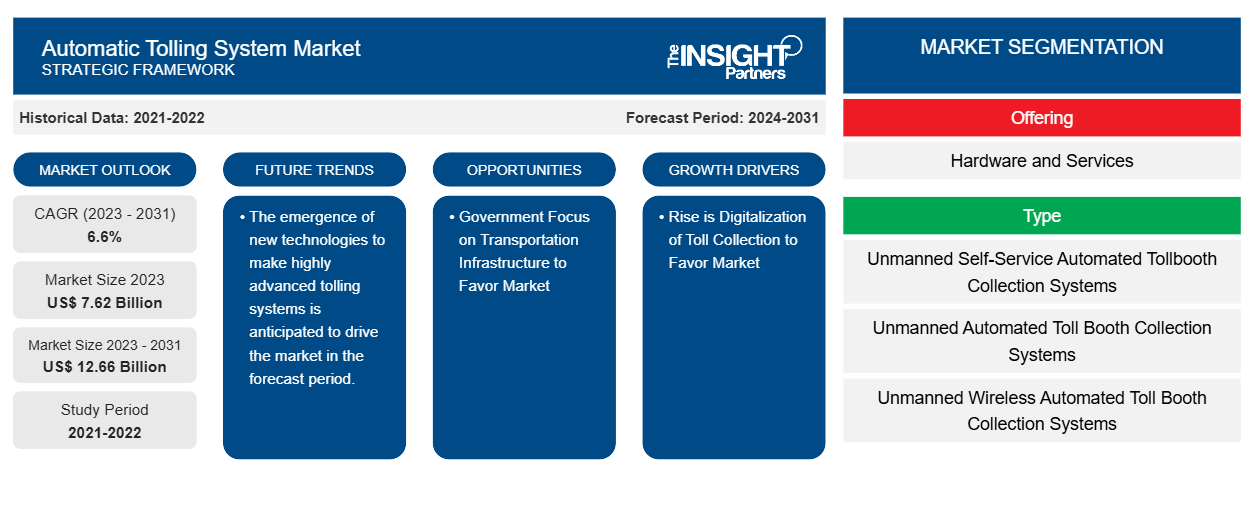Der Markt für automatische Mautsysteme soll von 7,62 Milliarden US-Dollar im Jahr 2023 auf 12,66 Milliarden US-Dollar im Jahr 2031 anwachsen. Der Markt wird zwischen 2023 und 2031 voraussichtlich eine durchschnittliche jährliche Wachstumsrate von 6,6 % verzeichnen. Die zunehmende Digitalisierung der Mauterhebung sowie langfristige wirtschaftliche und sicherheitsrelevante Vorteile dürften die wichtigsten Treiber und Trends des Marktes sein.
Marktanalyse für automatische Mautsysteme
Der Markt für automatische Mautsysteme verzeichnet weltweit ein starkes Wachstum. Dieses Wachstum ist auf Faktoren wie die zunehmende Digitalisierung der Mauterhebung sowie langfristige wirtschaftliche und sicherheitsrelevante Vorteile zurückzuführen. Darüber hinaus wird erwartet, dass die steigende Nachfrage nach effektiven Mautmanagementsystemen in Schwellenländern und die Entstehung neuer Technologien zur Herstellung hochmoderner Mautsysteme den Markt in den kommenden Jahren ankurbeln werden.
Marktübersicht für automatische Mautsysteme
Elektronische Mautsysteme (ETC) erheben Mautgebühren, ohne dass der Fahrer etwas unternehmen oder anhalten muss. Das System belastet die Konten der registrierten Autobesitzer oder erkennt das Nummernschild für eine spätere Abrechnung, ohne dass die Fahrzeuge anhalten müssen. ETC-Spuren verbessern die Geschwindigkeit und Effizienz des Verkehrsflusses und sparen dem Fahrer Zeit.
Passen Sie diesen Bericht Ihren Anforderungen an
Sie erhalten kostenlos individuelle Anpassungen an jedem Bericht, einschließlich Teilen dieses Berichts oder einer Analyse auf Länderebene, eines Excel-Datenpakets sowie tolle Angebote und Rabatte für Start-ups und Universitäten.
-
Holen Sie sich die wichtigsten Markttrends aus diesem Bericht.Dieses KOSTENLOSE Beispiel umfasst eine Datenanalyse von Markttrends bis hin zu Schätzungen und Prognosen.
Markttreiber und Chancen für automatische Mautsysteme
Digitalisierung der Mauterhebung begünstigt Markt
Eine zunehmende Digitalisierung der Mauterhebung kann tatsächlich ein Treiber für den Markt für automatische Mautsysteme sein. Sie bietet verbesserte Effizienz und Komfort, geringere Betriebskosten, verbesserte Genauigkeit und Sicherheit, nahtlose Integration mit anderen Systemen, Datenerfassung und -analyse, Benutzerfreundlichkeit und -zufriedenheit, zunehmende staatliche Initiativen und Vorschriften sowie Vorteile für die Umwelt. Die Digitalisierung rationalisiert den Mauterhebungsprozess, reduziert den Bedarf an manuellen Mautsystemen und ermöglicht schnelle Transaktionen. Darüber hinaus verfügen mehrere digitale Mautsysteme über verschiedene Zahlungsmethoden , wie z. B. mobiles Bezahlen und elektronische Geldbörsen, was den Benutzerkomfort erhöht.
Fokus der Regierung auf Verkehrsinfrastruktur soll Markt fördern
Der Fokus der Regierung auf die Verkehrsinfrastruktur treibt tatsächlich den Markt für automatische Mauterhebung weltweit an. Laut dem US Census Bureau ist die US-Wohnbevölkerung im Jahr 2022 im Vergleich zu 2021 um 0,4 % gestiegen. In Nordamerika steigt die Bevölkerung, was die Regierungen dazu ermutigt hat, in den Aufbau einer effizienten Infrastruktur zu investieren, um eine wachsende Bevölkerung zu bewältigen und das Wirtschaftswachstum aufrechtzuerhalten. Der zunehmende Fokus auf den Wiederaufbau der alternden Infrastruktur und die Einbeziehung intelligenter Lösungen sind ein Schlüsselfaktor, der die Einführung automatischer Mauterhebungssysteme in der Region vorantreibt. Unter Berücksichtigung der oben genannten Parameter treibt der Fokus der Regierung auf die Verkehrsinfrastruktur den Markt für automatische Mauterhebung an.
Marktbericht zum automatischen Mautsystem – Segmentierungsanalyse
Wichtige Segmente, die zur Ableitung der Marktanalyse für automatische Mautsysteme beigetragen haben, sind Angebot und Typ.
- Basierend auf dem Angebot ist der Markt für automatische Mautsysteme in Hardware und Dienstleistungen unterteilt. Es wird erwartet, dass das Hardwaresegment im Prognosezeitraum einen erheblichen Marktanteil halten wird.
- Der Markt für automatische Mautsysteme ist nach Typ in unbemannte automatische Mautstellensysteme zur Selbstbedienung, unbemannte automatische Mautstellensysteme und unbemannte drahtlose automatische Mautstellensysteme unterteilt. Das Segment der unbemannten automatischen Mautstellensysteme zur Selbstbedienung wird im Prognosezeitraum voraussichtlich einen erheblichen Marktanteil halten.
Automatische Mautsystem Marktanteilsanalyse nach Geografie
Der geografische Umfang des Marktberichts über automatische Mautsysteme ist hauptsächlich in fünf Regionen unterteilt: Nordamerika, Asien-Pazifik, Europa, Naher Osten und Afrika sowie Süd- und Mittelamerika.
Nordamerika dominiert den Markt für automatische Mautsysteme. Die zunehmende Einführung von Technologien in verschiedenen Branchen in Nordamerika hat das Wachstum des Marktes für automatische Mautsysteme vorangetrieben. Faktoren wie die zunehmende Einführung digitaler Tools und hohe Technologieausgaben von Regierungsbehörden dürften das Wachstum des nordamerikanischen Marktes für automatische Mautsysteme vorantreiben. Darüber hinaus zwingt eine starke Betonung von Forschung und Entwicklung in den entwickelten Volkswirtschaften der USA und Kanadas die nordamerikanischen Akteure dazu, technologisch fortschrittliche Lösungen auf den Markt zu bringen. Darüber hinaus gibt es in den USA eine große Anzahl von Akteuren auf dem Markt für automatische Mautsysteme, die sich zunehmend auf die Entwicklung innovativer Lösungen konzentrieren. All diese Faktoren tragen zum Wachstum des Marktes für automatische Mautsysteme in der Region bei.fuelled the growth of the automatic tolling system market. Factors such as increased adoption of digital tools and high technological spending by government agencies are expected to drive the North American automatic tolling system market growth. Moreover, a strong emphasis on research and development in the developed economies of the US and Canada is forcing the North American players to bring technologically advanced solutions into the market. In addition, the US has a large number of automatic tolling system market players who have been increasingly focusing on developing innovative solutions. All these factors contribute to the region's growth of the automatic tolling system market.
Regionale Einblicke in den Markt für automatische Mautsysteme
Die regionalen Trends und Faktoren, die den Markt für automatische Mautsysteme im Prognosezeitraum beeinflussen, wurden von den Analysten von Insight Partners ausführlich erläutert. In diesem Abschnitt werden auch die Marktsegmente und die Geografie für automatische Mautsysteme in Nordamerika, Europa, im asiatisch-pazifischen Raum, im Nahen Osten und Afrika sowie in Süd- und Mittelamerika erörtert.

- Erhalten Sie regionalspezifische Daten zum Markt für automatische Mautsysteme
Umfang des Marktberichts zum automatischen Mautsystem
| Berichtsattribut | Details |
|---|---|
| Marktgröße im Jahr 2023 | 7,62 Milliarden US-Dollar |
| Marktgröße bis 2031 | 12,66 Milliarden US-Dollar |
| Globale CAGR (2023 - 2031) | 6,6 % |
| Historische Daten | 2021-2022 |
| Prognosezeitraum | 2024–2031 |
| Abgedeckte Segmente |
Durch das Angebot
|
| Abgedeckte Regionen und Länder |
Nordamerika
|
| Marktführer und wichtige Unternehmensprofile |
|
Dichte der Marktteilnehmer für automatische Mautsysteme: Die Auswirkungen auf die Geschäftsdynamik verstehen
Der Markt für automatische Mautsysteme wächst rasant, angetrieben durch die steigende Nachfrage der Endnutzer aufgrund von Faktoren wie sich entwickelnden Verbraucherpräferenzen, technologischen Fortschritten und einem größeren Bewusstsein für die Vorteile des Produkts. Mit steigender Nachfrage erweitern Unternehmen ihr Angebot, entwickeln Innovationen, um die Bedürfnisse der Verbraucher zu erfüllen, und nutzen neue Trends, was das Marktwachstum weiter ankurbelt.
Die Marktteilnehmerdichte bezieht sich auf die Verteilung der Firmen oder Unternehmen, die in einem bestimmten Markt oder einer bestimmten Branche tätig sind. Sie gibt an, wie viele Wettbewerber (Marktteilnehmer) in einem bestimmten Marktraum im Verhältnis zu seiner Größe oder seinem gesamten Marktwert präsent sind.
Die wichtigsten auf dem Markt für automatische Mautsysteme tätigen Unternehmen sind:
- Conduent Business Services, LLC
- Efkon GmbH
- Feig Electronic
- Mitsubishi Heavy Industries Machinery Systems, Ltd.
- Neology, Inc
- Raytheon Technologies Corporation
Haftungsausschluss : Die oben aufgeführten Unternehmen sind nicht in einer bestimmten Reihenfolge aufgeführt.

- Überblick über die wichtigsten Akteure auf dem Markt für automatische Mautsysteme
Marktnachrichten und aktuelle Entwicklungen zum automatischen Mautsystem
Der Markt für automatische Mautsysteme wird durch die Erhebung qualitativer und quantitativer Daten nach Primär- und Sekundärforschung bewertet, die wichtige Unternehmensveröffentlichungen, Verbandsdaten und Datenbanken umfasst. Nachfolgend sind einige der Entwicklungen auf dem Markt für automatische Mautsysteme aufgeführt:
- Indien führt bald eine GPS-basierte Mauterhebung ein. Das Unionsministerium kündigte an, dass GPS-basierte Mauterhebungssysteme die bestehenden Autobahnmautstellen im Land ersetzen werden. Der Minister für Straßen, Verkehr und Autobahnen kündigte an, dass die Umstellung bereits im April dieses Jahres erfolgen werde. (Website der HT Auto Company, Juni 2024)
Marktbericht zum automatischen Mautsystem – Abdeckung und Ergebnisse
Der Bericht „Marktgröße und Prognose für automatische Mautsysteme (2021–2031)“ bietet eine detaillierte Analyse des Marktes, die die folgenden Bereiche abdeckt:
- Marktgröße und Prognose für automatische Mautsysteme auf globaler, regionaler und Länderebene für alle wichtigen Marktsegmente, die im Rahmen des Berichts abgedeckt sind
- Markttrends für automatische Mautsysteme sowie Marktdynamik wie Treiber, Einschränkungen und wichtige Chancen
- Detaillierte PEST/Porters Five Forces- und SWOT-Analyse
- Marktanalyse für automatische Mautsysteme mit Blick auf wichtige Markttrends, globale und regionale Rahmenbedingungen, wichtige Akteure, Vorschriften und aktuelle Marktentwicklungen
- Branchenlandschaft und Wettbewerbsanalyse, einschließlich Marktkonzentration, Heatmap-Analyse, prominenten Akteuren und aktuellen Entwicklungen auf dem Markt für automatische Mautsysteme
- Detaillierte Firmenprofile
- Historische Analyse (2 Jahre), Basisjahr, Prognose (7 Jahre) mit CAGR
- PEST- und SWOT-Analyse
- Marktgröße Wert/Volumen – Global, Regional, Land
- Branchen- und Wettbewerbslandschaft
- Excel-Datensatz
Aktuelle Berichte
Erfahrungsberichte
Grund zum Kauf
- Fundierte Entscheidungsfindung
- Marktdynamik verstehen
- Wettbewerbsanalyse
- Kundeneinblicke
- Marktprognosen
- Risikominimierung
- Strategische Planung
- Investitionsbegründung
- Identifizierung neuer Märkte
- Verbesserung von Marketingstrategien
- Steigerung der Betriebseffizienz
- Anpassung an regulatorische Trends























 Kostenlose Probe anfordern für - Markt für automatische Mautsysteme
Kostenlose Probe anfordern für - Markt für automatische Mautsysteme